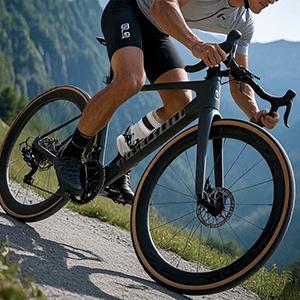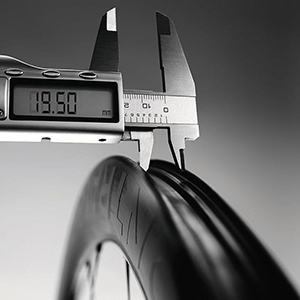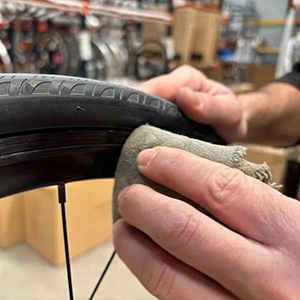
Choosing the Best Carbon Rims for Climbing
When you're tackling steep climbs, every gram counts. Choosing carbon fiber rims shouldn't just focus on light weight; consider rim stiffness, width, and how they perform on different trail conditions. The right wheels can help you climb with less effort and distribute energy more efficiently, which is why they're so popular among cyclists who prioritize lightweight and high-performance, helping you conquer hills with greater ease. In this guide, we'll take you through the best carbon rims for climbing, the trade-offs between different factors, and key considerations before buying a wheelset. Ultimately, you'll be able to choose the wheelset that best suits your goals and riding style.

When you’re climbing steep hills, the wheels on your bike play a bigger role than you might think. Carbon rims are lighter than traditional aluminum rims, which means you use less energy with each pedal stroke. That can make long climbs feel less exhausting and help you keep a steady pace.
Every gram you remove from your wheels reduces the effort needed to spin them uphill. Lighter carbon rims can make accelerations smoother and help you maintain momentum when the road tilts sharply. You’ll notice the difference most on long or steep climbs, where every bit of saved energy adds up.
Carbon rims are also stiffer than many alloy options. This stiffness means your pedaling power goes directly into moving the bike rather than flexing the wheel. You’ll feel a more responsive ride, especially when you push hard on steep sections or sprint out of corners.
On winding mountain roads, carbon rims can improve handling. They hold the line better in corners and respond predictably when you shift your weight. This gives you more confidence when climbing tight switchbacks or descending briefly before the next uphill section.
Choosing carbon rims isn’t just about style,it’s about making climbing easier, more efficient, and more enjoyable for you.
Key Factors to Consider When Choosing Carbon Rims for Climbing
Choosing the right carbon rims can be confusing with so many options available. Focusing on a few important factors can help you pick wheels that improve your climbing performance and match your riding style.
Weight
Lighter rims are easier to spin uphill. Every gram you save reduces fatigue on long climbs. However, ultra-light rims may trade some durability for weight. You want a balance that fits your riding style.
Rim Depth
Rim depth affects aerodynamics and handling:
Shallow Rims (28–35mm): Easier to handle in crosswinds and lighter.
Mid-Depth Rims (36–45mm): Offer a small aerodynamic boost while keeping climbing efficiency.
Rim Width
The internal width affects how your tire sits on the rim. Wider rims provide stability and comfort, while narrower rims are lighter and easier to accelerate. Consider the type of tires you like to ride and the terrain.
Material Quality
Not all carbon is the same. Higher-grade carbon fibers, like T800, are stiffer and stronger, which improves power transfer and durability. Lower-grade fibers may be lighter but less responsive on steep climbs.
Disc Brakes: Better for long descents and wet conditions.
Rim Brakes: Lighter but may heat up on long climbs, which can affect performance.
By paying attention to these factors, you can select rims that help you climb efficiently, feel responsive, and stay safe on the road.
Tubeless vs Clincher vs Tubular for Climbers
|
Rim Type |
Pros |
Cons |
Best For |
|
Clincher |
Easy to install and replace tires; widely available; compatible with most bikes |
Slightly heavier; higher rolling resistance compared to tubeless |
Casual climbing, training rides, riders who value convenience |
|
Tubeless |
Lower rolling resistance; fewer flats; better traction on climbs |
Requires sealant and careful installation; may need maintenance |
Serious climbers, long rides, variable terrain |
|
Tubular |
Lightest option; excellent cornering and power transfer |
Harder to repair or replace tires; more expensive |
Competitive racing, steep climbs, experienced riders |
This table shows the key differences between rim types so you can quickly decide which one fits your riding style. Consider how often you ride, the terrain you climb, and how much maintenance you’re willing to handle. The right choice can make your uphill rides smoother, safer, and more efficient.
What Is the Best Rim Width for Climbing?
The width of your carbon rims plays a bigger role than many riders realize. It affects tire fit, comfort, handling, and even climbing efficiency. Choosing the right width can help you ride more confidently on steep climbs and technical terrain.

28–30mm Internal: Offers a balance of comfort and stability. Good for riders using wider tires or rougher roads.
Above 30mm Internal: Adds comfort but slightly increases weight. Best for endurance climbs or mixed terrain.
Cornering Stability: Wider rims help maintain traction in turns.
Weight Trade-Off: Narrow rims save grams, which matters on steep climbs.
When choosing rim width, think about the terrain, tire size, and how you ride. You want a setup that feels stable, efficient, and responsive.
Weight, Stiffness, and Comfort Balance
In the previous section, we learned that rim width has a certain impact on climbing performance. So, does the balance between weight, stiffness, and comfort have a significant impact on your riding? Read on.
Weight Matters
Lighter rims reduce rotational mass, which makes it easier to spin uphill. Every gram saved can help you maintain a steady pace on long climbs. But extremely light rims may sacrifice durability, so think about your riding style and terrain.
Stiffness for Power Transfer
Stiffer rims flex less under your pedaling force. This means more of your power goes into moving the bike instead of bending the wheel. You’ll notice sharper responsiveness when accelerating or climbing steep sections.
Comfort Considerations
Comfort is often overlooked. Too stiff, and your ride can feel harsh, especially on rough roads. Wider rims with appropriate tires can absorb vibrations and make long climbs less tiring.
Finding the Right Balance
Lighter rims for short, steep climbs or racing.
Stiffer rims if you want precise handling and power transfer.
Slightly wider or more compliant rims for comfort on long rides.
The key is to consider all three factors together. The right combination depends on how you climb, your body weight, and the type of roads you ride. By balancing weight, stiffness, and comfort, your climbing experience becomes smoother, faster, and more enjoyable.
Maintenance and Longevity Tips for Climbing Rims
Keeping your carbon rims in good condition ensures they last longer and perform at their best. A little care goes a long way, especially when you ride steep climbs frequently.
Regular Inspection
Before and after each ride, check your rims for cracks, dents, or other damage. Pay attention to the braking surface if you use rim brakes, as excessive wear can affect safety.
Cleaning Tips
Use a soft brush and mild soap to remove dirt and debris.
Avoid harsh chemicals that can damage the carbon or the resin.
Dry rims completely before storing to prevent moisture damage.

Conclusion
Choosing the right carbon climbing rim isn't just about picking the lightest. You also need to consider stiffness, rim width, tire setup, and how the wheel fits your riding style. By carefully balancing these factors, you can achieve a rim that makes climbing more efficient, responsive, and comfortable. Proper maintenance will keep your rims performing at their best. With the right setup, every climb feels smoother, allowing you to focus on enjoying your ride, not worrying about your wheels.
FAQ
1. Do carbon rims require special tires for climbing?
Not necessarily. Most standard road tires work, but pairing them with wider tires can improve comfort and grip on steep or rough climbs.
2. Can I mix carbon climbing rims with an aluminum wheelset?
Yes, but make sure the hubs and axles are compatible. Mixing materials may affect ride feel and braking performance.
3. Are carbon rims noisy when climbing?
Some carbon rims can produce a faint vibration or noise, especially on rough roads. Proper tire pressure and brake maintenance usually reduce it.
4. Are tubeless rims worth it for climbing?
Tubeless rims reduce rolling resistance and the risk of flats, which can make climbs smoother and more reliable, especially on long rides.
Categorías
Nuevo blog
Derechos de autor © 2025 Top-Fire Carbon Technology Co., Ltd. Reservados todos los derechos. Poder por

Red IPv6 admitida